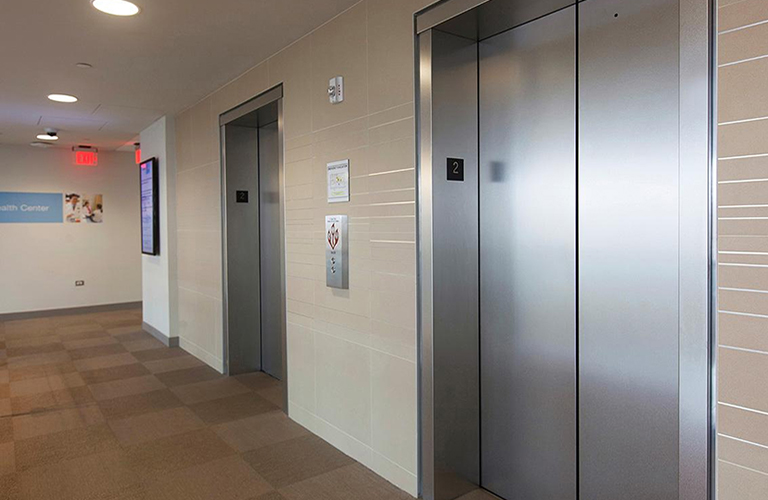In the changing urban and architectural environment, there has been a recurring need for space-efficient, low-cost, and optimal solutions. Amidst these solutions, the machine room less elevators (MRLs) are a revolutionary advancement in the domain of lifts. The lifts, with their abolition of the need for a machine room, not only changed the way people moved between floors, but also created avenues for more space-efficient and greener architectural designs.
This article discusses the future of machine room less elevators, their space savings, their savings on energy, and their friendliness towards the environment. We shall also take a peek into the advancements in technology transforming the future of the next generation of MRLs, their use in different industries, and what the future of this revolutionary technology has in store.
What are Machine Room-Less Elevators?
Traditionally, elevators for skyscrapers had a dedicated machine space, preferably on top of the building. The machine, drive, and other devices for the functioning of the lift were housed in this space. Though this solution worked for years, with its use, there were significant space and design constraints. Machine room less elevators (MRL) are a revolutionary solution for this. True to their names, such lifts don’t require a dedicated machine space. Instead, they house the devices needed, including the motor, drive mechanisms, and the control systems, inside the hoistway or the lift shaft.
This design reduces space available, and this is a major point, especially for urban environments where every square footage matters. The absence of a machine room reduces the footprint of the building and offers more flexibility and space usage.
Key Components of Machine Room-Less Elevators
To understand the complete benefits of MRL elevators, there’s a need for understanding the primary factors separating them from traditional systems. The primary ones are:
- Traction System: The traction system is commonly used in MRL lifts, compared with the traditional gearmotor and hydraulic systems. The traction system has lower power consumption and noise, and smoother ride. The drive and the motor are enclosed inside the hoistway, and there is no need for a dedicated machine space.
- Gearless Motors: A significant advantage of MRL lifts is the use of gearless motors. With gear-driven motors, gearless systems directly drive the lift’s pulley (sheave), and this reduces the amount of energy consumed and also noise levels.
- Control Systems: The control systems of MRL systems are mostly inside the hoistway or adjacent to the elevator shaft. The space requirements are minimized because of the compact design and limited space for machinery.
- Regenerative Drives: A regenerative drive is also present in a large percentage of the MRL systems, where the drive recycles the energy of the down-traveling elevator and returns it into the building’s electrical grid, or returns it into other systems of the building. This contributes significantly towards the savings of the elevator.
The Space-Saving Benefits of Machine Room-Less Elevators
One of the greatest benefits of selecting MRL elevators is their space-savings ability. Space, when it comes to architectural design, and even more so in urban environments, can be limited and very valuable. With their removal of a machine room, MRL elevators allow owners of buildings and builders to be able to use every square inch of space more constructively.
Maximizing Usable Area
The machines of conventional elevators will always take up considerable space, usually found among the upper floors of a building. Although it rarely gets used that way, MRL technology now allows a conversion of that space into other office, residential, or recreational uses. In residential buildings with very little space available, such savings in square footage can lead to more habitable living spaces.
Flexibility in Building Design
The elimination of the machine room also allows for greater design flexibility for architects while putting together buildings. Without the constraints imposed by a machine room, architects may kit their respective designs with inventive and pioneering features. Which is more useful in irregular shapes or buildings, whose planning space is either limited or complicated.
Smaller Shaft Diameter
MRL systems also allow for minimization of the overall elevator shaft. The smaller drive and machine also result in a smaller elevator shaft, contributing towards space savings. This can be very significant in space-constrained buildings, such as in multi-unit residential apartments, where even small savings on the shaft can be substantial.
Energy Efficiency and Sustainability of Machine Room-Less Elevators
The movement toward sustainable-building practices has gained speed in recent years with MRL elevators perfectly riding along the trend. Energy efficiency stands out as one of the main highlights of MRL elevators, putting them right in the center of the interest around modern buildings regarding reducing their carbon footprint.
Regenerative Drives for Power Savings
As mentioned above, regenerative drives are commonly employed in many of the MRL systems, and these can recapture the energy when the elevator returns and transfer it into the building’s electrical network. This minimizes overall energy usage and enhances the efficiency of the elevator system. With more than one MRL elevator in a building, overall savings can be substantial, and this can result in substantial savings on operating expenditure.
Reduced Power Consumption
Compared to traditional lift systems, MRL lifts consume lower levels of power. This can be explained by the absence of a heavy machine room, use of gearless motors, and removal of friction and wear from the system. Therefore, MRL lifts are generally more energy-efficient compared to their counterparts, contributing towards a building’s overall aspiration of being more energy-efficient.
Environmental Benefits
By using fewer kilowatt-hours and promoting regenerative use, machine room less elevators can reduce the carbon footprint of a building. Also, with more and more builders incorporating environment-conscious processes and materials when designing MRL systems, there’s utilization of recyclable material for components and adoption of environment-conscious processes for fabrication.
Compliance with Green Building Regulations
Many building projects today pursue rigorous green building certifications, such as LEED (Leadership in Energy and Environmental Design). The space and energy-efficient design of MRL elevators positions them as the best solution for LEED-certification-aimed buildings. With their ecological benefits, they are the natural choice for green building practices.
Technological Advancements of Machine Room-Less Elevators
Over the period of ten years, there has been a range of innovations with regard to performance and functionality of machine room less elevators. The innovations not only increase the performance of the MRL systems, but also ensure a more improved user experience and overall safety.
AI and Smart Technologies
One of the more intriguing advancements in lift technology has been the adoption of artificial intelligence (AI) and smart building systems. The two can be implemented such that the MRL lifts can be made smarter and more responsive. To explain, AI can be implemented for real-time passenger demand optimal routing of the lift, reducing the waiting times and overall efficacy.
Smart technologies also facilitate predictive maintenance, reducing breakdowns and extending the longevity of the elevator system. The elevator can be monitored for its health with sensors inserted into the elevator, and real-time data can be sent to technicians who can then take action on possible malfunctions before they can grow into significant issues.
Enhanced Safety Features
Safety has always been priority number one in the elevator field, and that hasn’t changed. Modern MRL systems are endowed with advanced safety features such as redundant braking systems, emergency lighting, and communication systems. Safety features make sure that passengers are taken care of in the case of any power failures or mechanical failures.
Additional modern technology, such as advanced door control systems, allows doors to operate smoothly, thus lessening the likelihood of accidents. Other MRL systems are rolling out with touchless or motion sensing technology, making environments more convenient and hygienic by allowing passengers to call an elevator without touching buttons.
Remote Monitoring and Control
With the arrival of smart buildings, MRL lifts can be monitored and regulated from a distance. The performance and status of the lift can be transmitted real-time to facility managers. This ensures there can be predictive maintenance and the lift can be made optimal.
Applications of Machine Room-Less Elevators
Machine room less elevators are very convenient and can be implemented in different forms of buildings, ranging from office skyscrapers to residential low-rise housing. Some of the most typical uses are mentioned below:
Commercial Buildings
In commercial buildings, MRL lifts offer a space-efficient and low-energy solution for movement vertically. With their low footprint and low-energy configuration, MRL lifts are best for office environments where space and operational costs are significant. They also satisfy the sustainability goals of the majority of companies, which increasingly seek green building certifications.
Residential Buildings
MRL elevators are optimal for residential buildings, more so in urban environments where space becomes limited. From a residential complex with a variety of floors to a luxury residential skyscraper, space with maximum utilization is achieved with MRL elevators and provides a convenient and smooth experience for residents. Space savings in architectural design can be a significant contributor towards lowering the overall cost of construction.
Healthcare Facilities
Hospitals and healthcare centers also have heavy usage and complex configurations. The compact, low-energy configuration of MRL lifts offers the best solution for transportation in such environments. The heavy usage and heavy loads, with frequent use, also find their best companion in the utilization of MRL lifts.
Hospitality and Retail Spaces
In hotels, shopping malls, and other retail spaces, MRL lifts provide a smooth and energy-efficient way of transporting individuals from one floor to the other. Space savings with attractive looks ensure that MRL lifts are very much in demand in such industries, where performance and looks are of equal value.
The Future of Machine Room-Less Elevators
The future of machine room less elevators is bright; further advances in technology, sustainability, and design will augment the outlook for growth. They will include further features with the following trends in the next few years:
- Integration with Building Automation Systems: MRL will find extensive integration in building management systems as buildings get smarter in their operations and the user experience.
- Greater Energy Efficiency: Most probably, MRL in the near future will get even more energy-efficient by way of incorporating renewable energy sources and using the best energy conservation techniques.
- Enhanced Passenger Experience: Enhanced passenger experience. Departure-level controls, direct destination dispatching, touchless operation, or even voice-activated systems are options to be expected from MRL systems.
- Global Adoption: More rapid growth and adoption of MRL elevators with growing attention to sustainability and space optimization are expected over the years, particularly in developing markets with high urbanization rates.
TectronicsIndia: Leading the Way with MRL Technology
As the demand for space-efficient and environment-friendly solutions for buildings becomes more widespread, industry leaders like TectronicsIndia are forerunners in the establishment of machine room less elevators solutions. Besides supplying industry-leading MRL elevator systems, TectronicsIndia also ensures every solution addresses the specific needs of their clients, from installation and design to maintenance and service. With their commitment towards space-efficient, environment-friendly, and low-energy-consuming systems for elevators, they are a worthy choice for architects, builders, and facility managers who want to install MRL systems in their projects.
By embracing the advancements of MRL technology, TectronicsIndia is helping shape the future of vertical transportation, providing best-of-the-best solutions for today’s modern practices.
Conclusion
The rise of the machine room less elevators is a giant leap in the history of vertical transportation systems. With space-efficient solutions, greater energy savings, and compatibility with sustainability needs, the MRL lifts are revolutionizing the way we construct and design structures. With future innovations, they are headed towards becoming the future of architectural design, with solutions for the future being more innovative, more efficient, and more environment-friendly.
As cities grow and rise, more and more space-efficient and sustainable solutions will be necessary. The future of urban space brightens with the arrival of machine room less elevators, ushering in a more space-optimized and more sustainable urban space.



